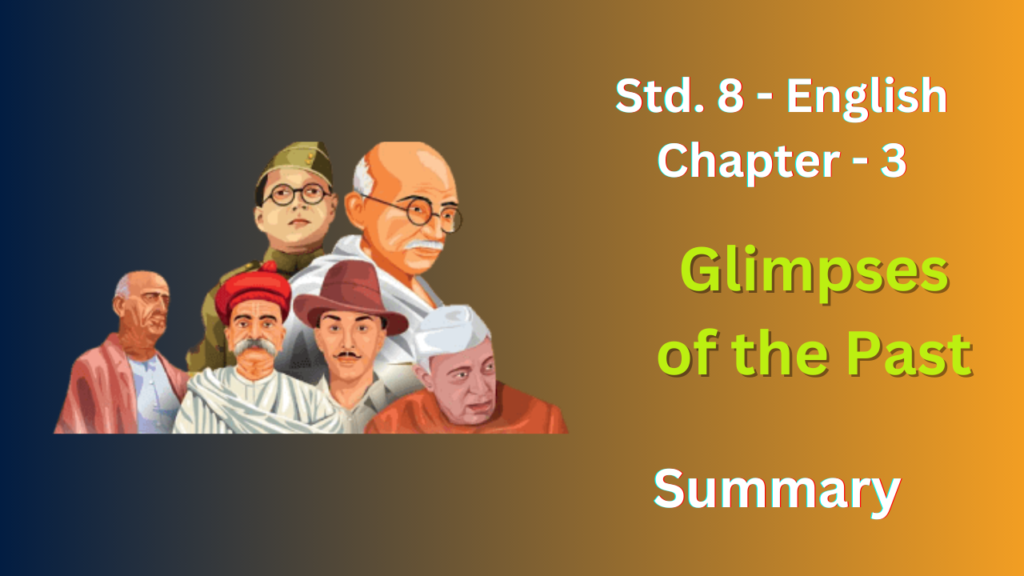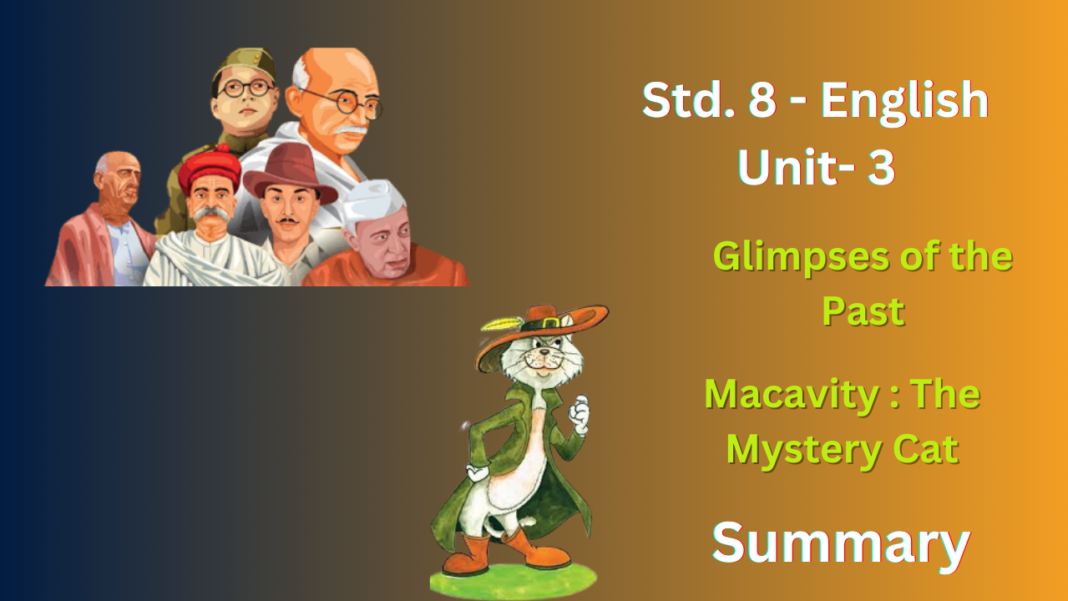NCERT Solutions for Class 8 English Chapter 3
Glimpses of the Past
The chapter “Glimpses of the Past” from your 8th standard English textbook provides a historical overview of India from 1757 to 1857, focusing on events leading to the First War of Independence. Here’s a summary:
Setting the Stage:
- The chapter starts by highlighting the disunity among Indian rulers in the 18th century. This weakness allowed the British East India Company to gain a foothold in India.
- The British exploited this disunity by using a “divide and rule” strategy, manipulating Indian rulers against each other.
British Rule and Its Effects:
- The chapter describes how the British gradually expanded their power, replacing local rulers and imposing heavy taxes on farmers and artisans.
- These harsh policies led to widespread poverty and resentment towards the British.
Social Conditions:
- The chapter mentions the poor social conditions in India at that time. Social evils like child marriage, untouchability, and sati were prevalent.
- Religious leaders often reinforced these practices, hindering progress.
Resistance and the Rise of Patriotism:
- The chapter briefly mentions some individuals who challenged the British rule. One example is Raja Ram Mohan Roy, a social reformer who advocated against social evils and promoted education.
- The growing discontent with British rule laid the groundwork for the eventual First War of Independence in 1857.

NCERT Solutions for Class 8 English Chapter 3
Comprehension Check
1. Look at picture 1 and recall the opening lines of the original song in Hindi. Who is the singer? Who else do you see in this picture?
Ans :
Opening Lines:
The opening lines of the song in the picture are most likely:
- “Aye mere watan ke logon…” (Oh, people of my country…)
Singer:
The singer is :
- Lata Mangeshkar
In Picture :
Pt. Jawaharlal Nehru, Lai Bahadur Shastri and Mrs. Indira Gandhi
2 .In picture 2 what do you understand by the Company’s ‘superior weapons?
Ans : The East India Company’s success in India stemmed from a combination of factors, including advanced weaponry like guns and diplomatic maneuvering that exploited existing rivalries among Indian rulers
3. Who is an artisan? Why do you think the artisans suffered? (Picture 3)
Ans : Skilled craftspeople, known as artisans, faced hardship as the demand for their handcrafted goods dwindled in the Indian market.
4. Which picture, according to you, reveals the first sparks of the fire of revolt?
Ans : Picture 7 shows the early signs of the upcoming uprising.
Working With Text
Answer the following question
1. Do you think the Indian princes were short-sighted in their approach to the events of 1757?
Ans : The Indian princes’ short-sighted strategy of seeking British aid in their internal conflicts ultimately backfired, allowing the British to gain a foothold and become the de facto rulers.
2. How did the East India Company subdue the Indian Princes?
Ans : The East India Company subdued Indian princes through a clever strategy: divide and rule. They exploited existing rivalries, wielded superior military power, and manipulated local politics, ultimately outsmarting and overpowering them.
3. Quote the words used by Ram Mohan Roy to say that every religion teaches the same principles.
Ans : Cows are of different colours, but the colour of their milk is the same. Different teachers have different opinions but the essence of every religion is the same.
4. In what ways did the British officers exploit Indians?
Ans : British officers squeezed Indians dry through heavy taxes, forced crops, and low wages. They divided rulers, discriminated against Indians, and crushed local industries, prioritizing British wealth over Indian well-being.
5. Name these people.
- The ruler who fought pitched battles against the British and died fighting.
- The person who wanted to reform the society.
- The person who recommended the introduction of English education in India.
- Two popular leaders who led the revolt (choices may vary.)
Ans :
- The ruler who fought pitched battles against the British and died fighting: Tipu Sultan of Mysore
- The person who wanted to reform the society: Raja Ram Mohan Roy
- The person who recommended the introduction of English education in India: Lord Macaulay
- Two popular leaders who led the revolt (choices may vary): Here are a few examples, but there were many leaders involved:
- Rani Laxmibai of Jhansi
- Mangal Pandey
- Bahadur Shah Zafar
- Tatya Tope
- Nana Sahib
6. Mention the following.
- Two examples of social practices prevailing then.
- Two oppressive policies of the British.
- Two ways in which common people suffered.
- Four reasons for the discontent that led to the 1857 War of Independence.
Ans :
- Social Evils: Caste system, Sati
- British Brutality: High taxes, Doctrine of Lapse
- People’s Plight: Poverty, Land loss
- Seeds of Rebellion: Political control, Economic exploitation, Cultural disrespect, Religious outrage (Enfield rifles)
Working With Language
1.Change the following sentences into indirect speech.
(i) First man: We must educate our brothers.
Second man: And try to improve their material conditions.
Third man: For that we must convey our grievances to the British Parliament.
The first man said that________________ a__________________________________
The second man added that they _____b______________________________________
The third man suggested that___________ c__________________________________
(ii) First soldier: The white soldier gets huge pay, mansions and servants.
Second soldier: We get a pittance and slow promotions.
Third soldier: Who are the British to abolish our customs?
The first soldier said that______________ a___________________________________
The second soldier remarked that_____ b ______________________________________
The third soldier asked___________________ c_______________________________
Ans :
(i)
- The first man said that they must educate their brothers. (a)
- The second man added that they should try to improve their material conditions. (b)
- The third man suggested that they convey their grievances to the British Parliament. (c)
(ii)
- The first soldier said that the white soldier gets huge pay, mansions, and servants. (a)
- The second soldier remarked that they (the Indian soldiers) get a pittance and slow promotions. (b)
- The third soldier asked who the British were to abolish their customs. (c)
Speaking and Writing
(i)Ask one another questions about the pictures.
- Where is the fox?
- How did it happen?
- What is the fox thinking?
- Who is the visitor?
- What does she want to know?
- What is the fox’s reply?
- What happens next?
- Where is the goat?
- Where is the fox now?
- What is the goat thinking?
Ans :
The fox found itself trapped at the bottom of the well.
She fell into the well accidentally.
The fox thinks how to get out.
Goat is a visitor.
She wants to know whether the water is sweet or not.
The fox replies that the water is very sweet and she had a lot of it.
The goat wanted to taste the water.
The goat is dragged into the water by the fox.
The fox comes out of the well.
The goat is thinking of her mother’s advice not to trust any stranger.
(ii)Write the story in your own words. Give it a title.
Ans :
A plump fox named Beatrice trotted along a dusty path, her nose twitching with the scent of a juicy rabbit. Lost in her hunt, she didn’t notice the gaping maw of the old well hidden by overgrown vines. With a surprised yelp, Beatrice tumbled headfirst into the cool, damp darkness.
Shaken but unharmed, Beatrice landed with a thump at the bottom. Moonlight filtered faintly through a narrow opening high above, casting an eerie glow on the rough stone walls. Panic clawed at her throat. How would she escape this dank prison?
Suddenly, a curious bleat echoed from above. Beatrice looked up to see a young goat peering over the edge, its large eyes wide with concern.
“Is the water good down there?” the goat inquired, its voice trembling slightly.
Beatrice, ever the opportunist, seized her chance. “Excellent!” she exclaimed, her voice dripping with feigned delight. “The sweetest water I’ve ever tasted!”
The goat’s ears perked up. “Really? I am terribly thirsty,” it bleated.
Beatrice, her heart pounding, continued her act. “There’s plenty to share, my friend! Just come a little closer…”
Lured by the promise of a refreshing drink, the goat leaned further over the well. In a flash, Beatrice lunged. With a powerful shove of her hind legs, she sent the unsuspecting goat tumbling headfirst into the well.
Beatrice landed on the goat’s back with a satisfying thud, using it as a stepping stone. Clambering up the terrified animal’s body, she reached the edge and scrambled out, leaving the gullible goat bleating in dismay.
Beatrice, free once more, cast a triumphant glance back at the well. “Fools like that deserve what they get,” she scoffed, before disappearing into the night.
But as she trotted away, a nagging voice whispered in her ear. Her victory tasted hollow. The memory of the goat’s trusting eyes and the echo of its desperate bleats lingered, a stark reminder of the price of her cunning.
Macavity : The Mystery Cat
The poem “Macavity The Mystery Cat” describes a notorious criminal cat named Macavity. Here’s a summary:
Macavity’s Description:
- Tall and thin ginger cat with sunken eyes and a constantly wrinkled brow.
- Unkempt fur and whiskers, suggesting a lack of care for appearances.
- Described as “hidden paw” and “master criminal,” implying he’s cunning and avoids detection.
Macavity’s Crimes:
- The poem doesn’t detail specific crimes, but suggests he’s a master thief and trickster.
- He seems to defy human laws and even the laws of nature (like floating in the air).
- The Scotland Yard Police and the Flying Squad are helpless against him.
Overall Theme:
- The poem plays on the stereotype of mischievous cats, but takes it to an extreme.
- It creates a sense of mystery and intrigue around Macavity’s character.
- It might be a humorous or satirical take on the idea of a criminal mastermind.

NCERT Solutions for Class 8 English Chapter 3
Working With The Poem
1. Read the first stanza and think.
(i) Is Macavity a cat really?
Ans : Yes
(ii) If not, who can Macavity be?
Ans :
- A brilliant criminal mastermind
- A symbol of undetectable evil
- A powerful figure committing hidden crimes
2. Complete the following sentences.
(i) A master criminal is one who …………………………..
(ii) The Scotland Yard is baffled because …………………..
(iii) …………………… because Macavity moves much faster than them.
Ans :
(i) A master criminal is one who can commit crimes and avoid detection.
(ii) The Scotland Yard is baffled because Macavity always seems one step ahead, leaving no trace and vanishing without a clue.
(iii) They cannot catch him because Macavity moves much faster than them.
3. “A cat, I am sure, could walk on a cloud without coming through”.
(Jules Verne)
Which law is Macavity breaking in the light of the comment above?
Ans : The Law of Gravity: The poem mentions Macavity’s ability to “make crime disappear” and the line “He breaks the law of gravity.” This, combined with Verne’s quote, suggests Macavity might be defying gravity, something a normal cat (or human) cannot do.
4. Read stanza 3, and then describe Macavity in two or three sentences of your own.
Ans : Based on stanza 3, Macavity is a ginger cat who appears tall and thin. His eyes are sunken and his brow is deeply lined, suggesting a thoughtful or possibly grumpy demeanor. Despite being a cat, he seems to neglect his appearance, with dusty fur and uncombed whiskers. He moves with a swaying motion, and despite seeming half-asleep, is always alert and aware of his surroundings.
5. Say ‘False’ or ‘True’ for each of the following statements.
(i) Macavity is not an ordinary cat.
(ii) Macavity cannot do what a fakir can easily do.
(iii) Macavity has supernatural powers.
(iv) Macavity is well-dressed, smart and bright.
(v) Macavity is a spy, a trickster and a criminal, all rolled in one.
Ans :
(i) True
(ii) False
(iii) True
(iv) False
(v) True:
6. Having read the poem, try to guess whether the poet is fond of cats. If so, why does he call Macavity a fiend and monster?
Ans : “The poet finds the cat’s agility, criminal cunning, and elusiveness of the law impressive, yet labels him a ‘fiend’ and ‘monster’ due to his law-breaking nature.”
7. Has the poet used exaggeration for special effect? Find a few examples of it and read those lines aloud.
Ans :
• He is the bafflement of Scotland Yard, the Flying Squad’s despair.
• His power of levitation.
• A fiend in feline shape, a monster of depravity.
NCERT Solutions for Class 8 English Chapter 3
FAQ’s
What is the main theme of Class 8 English Chapter 3″Glimpses of the Past”?
The main theme of “Glimpses of the Past” is the struggle for Indian independence from British colonial rule. It highlights the social, economic, and political conditions of India during the 18th and 19th centuries.
Who is the author of “Macavity: The Mystery Cat”?
“Macavity: The Mystery Cat” is written by T.S. Eliot, a renowned British poet and playwright.
What are the key events described in Class 8 English Chapter 3 “Glimpses of the Past”?
“Class 8 English Chapter 3 Glimpses of the Past” describes key events such as the arrival of the British in India, the exploitation of Indian resources, the uprising of 1857, and the various movements and efforts by Indian leaders to gain independence.
How does Class 8 English chapter 3 “Glimpses of the Past” help students understand Indian history?
Class 8 English Chapter 3 “Glimpses of the Past” helps students understand Indian history by providing a narrative that combines factual events with personal anecdotes, making the historical context more relatable and engaging for young readers.
What poetic devices are used in “Macavity The Mystery Cat”?
The poem “Macavity The Mystery Cat” uses various poetic devices such as rhyme, rhythm, alliteration, and personification to create a vivid and memorable character.
What lessons can be learned from “Glimpses of the Past”?
“Glimpses of the Past” teaches lessons about the importance of unity, resilience, and the determination to fight against oppression. It also highlights the sacrifices made by Indian leaders and common people in the struggle for freedom.
Where can students find NCERT solutions for Class 8 English Chapter 3?
Students can find NCERT solutions for Class 8 English Chapter 3 on various educational websites like education85.com, including the official NCERT website. These solutions provide detailed explanations and answers to all the questions in the textbook.









